Trees Birds Mammals Fish Amphibians Reptiles
Wild Algarve
Bookshop
Collybia tuberosa (Bull.) P. Kumm. - Lentil Shanklet
Phylum: Basidiomycota - Class: Agaricomycetes - Order: Agaricales - Family: Tricholomataceae
Distribution - Taxonomic History - Etymology - Identification - Culinary Notes - Reference Sources
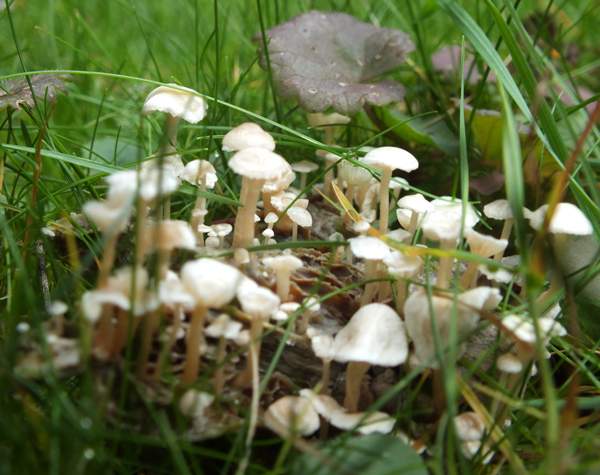
Mushrooms in the genus Collybia tend to live on the decaying remains of other mushrooms, and the Lentil Shanklet is no exception, favouring well-rotted mushrooms, particularly the Russulaceae.
Distribution
An infrequent to rare find in England, Wales and Scotland, where its distribution is patchy, Collybia tuberosa is also found across much of mainland Europe; it is also recorded in parts of North America and is reported to occur in Japan.
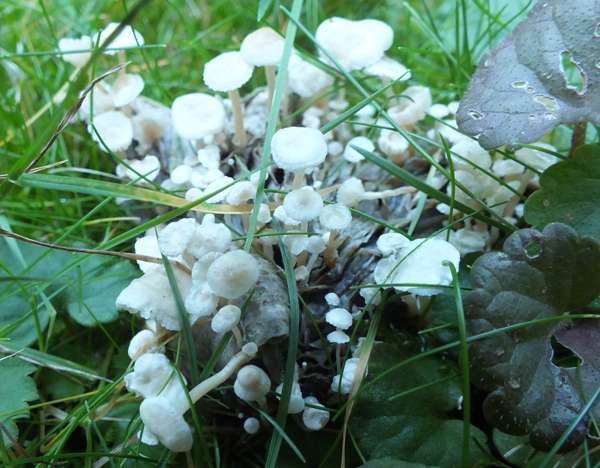
Taxonomic history
This mushroom was first described scientifically in 1792 by pioneering French mycologist Jean Baptiste Francois (Pierre) Bulliard, who named it Agaricus tuberosus. (In the early days of fungus taxonomy most gilled mushrooms were placed in a huge Agaricus genus, most of whose contents have since been redistributed to many other new genera.)
German mycologist Paul Kummer transferred this species to the genus Collybia in 1871, establishing its currently-accepted scientific name Collybia tuberosa.
Synonyms of Collybia tuberosa include Agaricus tuberosus Bull., Sclerotium cornutum Fr., Gymnopus tuberosus (Bull.) Gray, and Marasmius sclerotipes Bres.
Etymology
The generic name Collybia means 'small coin', which is a reference to the round flattish caps typical of many collybioid mushrooms. The specific epithet tuberosa comes from Latin and simply means tuberous and refers to the tuberous base of the stem of this mushroom.
Identification guide
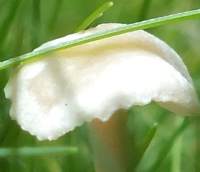 |
Cap
White or cream, occasionally developing a pale buff centre; convex, flattening often depressed but with a central umbo; margin often wavy and usually slightly incurved; dry and silky; 0.5 to 1.5cm across. |
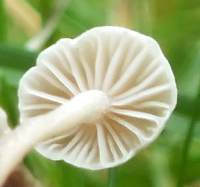
|
Gills
White, fairly crowded, adnate-emarginate.
Stem
White or pale cream, but browner towards the base; smooth, cylindrical, often contorted; 2 to 4cm long, 0.8 to 1.2mm diameter; no ring. The base of the stem is attached to a reddish-brown tuber embedded in the surface of the substrate. |
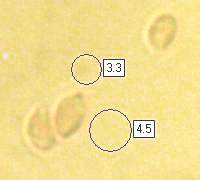 |
Spores
Ellipsoidal, smooth, 4-5.5 x 2.5-3.5µm.
Spore print
White. |
Odour/taste |
Not distinctive - any odour tends to be masked by the smell of the rotting mushroom on which the Lentil Shanklets are growing. |
Habitat & Ecological role |
Saprophytic on decaying mushrooms, notably the brittlegills (Russula species) and milkcaps (Lactarius species); usually forming large groups. |
Season |
Summer and autumn in Britain. |
Similar species |
Tubaria conspersa, the Felted Twiglet, looks similar when seen from above, but as well as growing on wood it differs in producing brown spores. |
Culinary Notes
Although lentils (the pulses, that is) are edible, the Lentil Shanklet is generally considered to be an inedible fungus.
Reference Sources
Fascinated by Fungi, 2nd Edition, Pat O'Reilly 2016, reprinted by Coch-y-bonddu Books in 2022.
Funga Nordica: 2nd edition 2012. Edited by Knudsen, H. & Vesterholt, J. ISBN 9788798396130
BMS List of English Names for Fungi
Dictionary of the Fungi; Paul M. Kirk, Paul F. Cannon, David W. Minter and J. A. Stalpers; CABI, 2008
Taxonomic history and synonym information on these pages is drawn from many sources but in particular from the British Mycological Society's GB Checklist of Fungi.
Top of page...
Fascinated by Fungi. Back by popular demand, Pat O'Reilly's best-selling 450-page hardback book is available now. The latest second edition was republished with a sparkling new cover design in September 2022 by Coch-y-Bonddu Books. Full details and copies are available from the publisher's online bookshop...